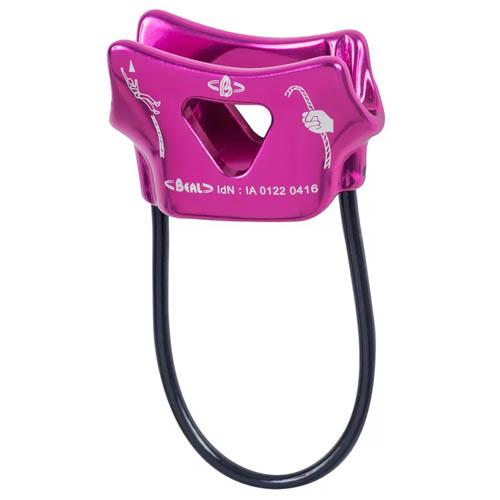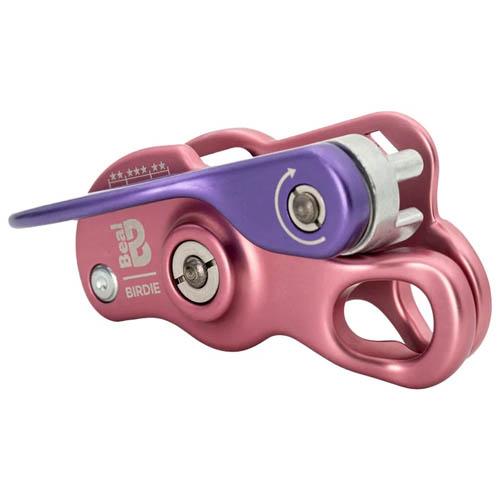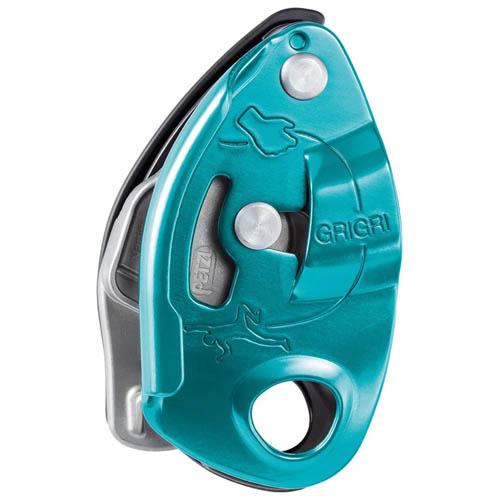How to choose a belay device?
When you start climbing, it's essential to get some basic equipment for beginners such as a harness, a pair of climbing shoes, a good helmet, a locking carabiner and a descender. But how do you choose this gear wisely when you're new to the sport? That’s why at Glisshop, we’re here to help you select your PPE and climbing gear. This way, you can be confident you're buying the equipment best suited to your abilities and style of climbing.
Key points to remember
- Choose a belay device according to your type of climbing: indoor wall, crag, or multi-pitch route
- Tube-style devices (Verso, Reverso, ATC Guide) are lightweight, versatile, and ideal for developing your skills
- Assisted-braking devices (Smart, Mega Jul) provide enhanced safety for beginners
- Auto-locking devices (Grigri, Birdie, Matik) ensure maximum security but require experience to use properly
- Always check the rope diameter compatibility before purchasing
- Never let go of the brake strand and always keep an eye on the climber
What is a climbing descender and what is it used for?
The belay/descender device is a crucial component in the belay chain for both climbing and mountaineering. It allows the climber’s upward progress and abseil descent to be controlled by regulating the speed of the rope passing through it. The primary function of the descender is to provide enough friction to slow or stop the rope in the event of a fall, thereby ensuring the climber’s safety. There are three main types of descenders, each with its own features and benefits: tube-style belay devices, assisted braking devices, and auto-locking belay devices.
Tube-style or tubular belay devices
Tube-style belay devices are among the most commonly used due to their simplicity and versatility. They work by generating friction on the rope through their tubular shape. When the rope is held correctly below the device, it acts as a mechanical brake, multiplying the gripping force of the hand and transferring the climber’s weight and the energy of a fall to the harness via the belay loop. With a minimal weight, an appealing price, and exceptional versatility, these belay/descender devices have quickly become essential for both climbing and mountaineering.

Our selection of tube-style belay devices:
Petzl Verso
The Verso is Petzl’s most basic tube-style device. This simple basket design features two rope slots that can be alternated to distribute wear. The Verso is also equipped with specially shaped grooves to improve braking performance. It is ideal for indoor use and for beginners on single-pitch routes outdoors.
Weight of the Verso: 55g
Compatible with single ropes from 8.5 to 11 mm, half ropes from 7.1 to 9.2 mm, and twin ropes from 6.9 to 9.2 mm

Petzl Reverso
The Reverso is simply the natural evolution of the Verso. This versatile descender uses the same design as the Verso but adds a reinforced loop for guide mode use, as well as a small loop for releasing the second climber’s belay on multi-pitch routes. For just a few extra grams compared to the basic Verso, the Reverso offers much greater versatility, allowing you to climb indoors or outdoors, on single-pitch or multi-pitch routes.
Weight of the Reverso: 57g
Compatible with single ropes from 8.5 to 11 mm, half ropes from 7.1 to 9.2 mm, and twin ropes from 6.9 to 9.2 mm

Black Diamond ATC Guide
The ATC Guide is a tube-style descender that offers an additional feature for belaying two second climbers simultaneously on multi-pitch routes. It is particularly valued for its ability to handle heavy loads and for its ease of use. The ATC Guide is widely used by mountain guides and climbing instructors thanks to its versatility and reliability. It is often compared directly to the Petzl Reverso.
Note: this device is available in two versions depending on rope diameter:
- ATC Guide (80g): compatible with single ropes from 8.9 to 11 mm, half ropes from 8.1 to 11 mm, and twin ropes from 8.1 to 11 mm
- ATC Alpine Guide (73g): compatible with single ropes from 8.5 to 9 mm, half ropes from 7.3 to 9 mm, and twin ropes from 6.9 to 9 mm
If you’re a beginner, you should opt for the basic ATC Guide, which is compatible with standard ropes typically used in climbing gyms.

Beal Air Force
The Air Force is an innovative descender that combines the advantages of tube-style devices with assisted braking. It is designed to provide enhanced rope control, which is especially useful in situations where a rapid descent is required. The Air Force is appreciated for its ability to handle ropes of varying diameters, making it a versatile choice for different types of climbing.
This descender is available in two versions: the Air Force 1 and the Air Force 3. The Air Force 1 can be compared to the Verso and is intended for beginners, both for indoor climbing and single-pitch routes, while the Air Force 3 is positioned against the Reverso, offering all the necessary features for multi-pitch climbing and mountaineering.
- Air Force 1 (36g): compatible with ropes from 8.5 mm to 10.5 mm
- Air Force 3 (90g): compatible with ropes from 7.3 mm to 10.5 mm

Air Force 1

Air Force 3
Camp Piu
The Piu is a compact and lightweight descender, ideal for climbers looking for a simple and effective solution. It is particularly well suited to crag climbing, both on single-pitch and multi-pitch routes. The Piu is appreciated for its ease of use and low bulk, making it a popular choice among climbers of all levels.
Like the Reverso, it features a guide mode for belaying one or two second climbers on multi-pitch routes, along with a small auxiliary loop for releasing the belay if needed.
- Piu 2 (82g): compatible with single ropes from 8.9 mm to 11 mm and with half and twin ropes from 7.6 mm to 9 mm

Assisted-braking belay devices
Assisted-braking belay devices are designed to enhance safety by helping the belayer slow down the rope in the event of a fall. They are especially useful for beginner climbers or in situations where increased safety is required.
Mammut Smart
The Mammut Smart is an assisted-braking belay device known for its simplicity and effectiveness. It is designed to almost automatically lock the rope in the event of a climber’s fall, providing added safety. The Smart is ideal for beginner climbers, children, novice groups, or situations where maintaining constant attention is challenging. The device requires a short familiarisation period, but once mastered, belaying is smooth and easy for both lead climbing and top-roping.
- Weight: 80g
- Rope diameter: 8.7 mm to 10.5 mm (single ropes only)

Edelrid Jul / Mega Jul / Giga Jul
The Jul, Mega Jul and Giga Jul from Edelrid are assisted-braking belay devices that offer excellent versatility. They can be used for top-rope and lead belaying, as well as for abseiling. Their design allows compatibility with ropes of various diameters, making them a popular choice among climbers of all levels. The main advantage of Edelrid’s devices lies in their ability to provide braking assistance without compromising rope smoothness.
The Jul is best suited for indoor and single-pitch climbing, while the Mega Jul is more versatile and works for multi-pitch climbing with one or two second climbers thanks to its guide mode. The Giga Jul combines all the advantages of the Mega Jul but also includes a switch system that allows you to alternate between assisted braking mode and tube mode.
- Jul (105g): rope diameter from 8.7 mm to 10.5 mm (single ropes only)
- Mega Jul (75g): compatible with single ropes from 8.6 to 10 mm, half ropes from 8.2 to 10 mm, and twin ropes from 7.8 to 10 mm
-
Giga Jul (121g):
Assisted braking mode: compatible with single ropes from 8.6 to 10 mm, half ropes from 7.9 to 9.2 mm, and twin ropes from 7.1 to 8.9 mm
Manual free mode: compatible with single ropes from 8.6 to 10 mm, half ropes from 8.6 to 9 mm, and twin ropes from 7.1 to 9.2 mm



Auto-locking belay devices
Auto-locking belay devices are designed to automatically lock the rope in the event of a fall, offering maximum safety. However, their use requires experience and solid belaying skills, as managing slack is more delicate than with standard or assisted-braking devices.
Petzl Grigri / Grigri+ / Neox
The Grigri, Grigri+ and now the Neox from Petzl are the most well-known auto-locking belay devices on the market. They are widely used thanks to their reliability and ease of use. These devices are designed to automatically lock the rope in the event of a fall using a metal cam system, providing maximum safety. The Grigri is especially popular for top-rope belaying. The new Neox builds on the core design of the Grigri but includes an integrated pulley system to improve rope handling during lead climbing. The Grigri+, on the other hand, features an anti-panic mechanism on the handle that locks the rope if the lever is pulled too far. It is also fitted with a selector (lead/top-rope) that lets you adjust the locking sensitivity.
These devices must be used with care and in strict accordance with the manufacturer’s instructions.
- Grigri (175g): compatible with single ropes from 8.5 mm to 11 mm; optimised for diameters from 8.9 mm to 10.5 mm
- Grigri+ (200g): compatible with single ropes from 8.5 mm to 11 mm; optimised for diameters from 8.9 mm to 10.5 mm
- Neox (235g): compatible with single ropes from 8.5 mm to 11 mm; optimised for diameters from 8.9 mm to 10.5 mm

Beal Birdie
The Beal Birdie is an auto-locking belay device designed to compete directly with Petzl’s Grigri. It is built to offer maximum safety while remaining easy to use. Like the Grigri, it uses a cam-assisted locking mechanism and features a side-opening plate for rope insertion. However, unlike the Grigri, which has a plastic handle, the Birdie is fully made of metal. The Birdie is ideal for climbers seeking a highly secure solution for both top-rope and lead belaying.
- Birdie (210g): compatible with single ropes from 8.5 mm to 10.5 mm

Edelrid Pinch
The Edelrid Pinch is an auto-locking belay device offering excellent versatility. It stands out from the competition thanks to its closure system that attaches directly to the belay loop. There’s no need for a carabiner, which eliminates the risk of it twisting during a fall. This model is also equipped with an anti-panic mechanism on the handle, which locks the rope if pulled too hard. The Edelrid Pinch is therefore ideal for both top-rope and lead belaying.
- Pinch (234g): compatible with single ropes from 8.5 mm to 10.5 mm

Camp Matik
Among the range of auto-locking belay devices, the Matik is a cam-assisted device with a handle, similar to the Grigri+. The Matik offers very precise control during descent, along with an anti-panic system: if the handle is pulled too hard or too quickly, the device instantly locks the rope. It’s particularly useful for long top-rope climbing sessions, but can also be used for lead belaying.
- Matik (276g): compatible with single ropes from 8.6 mm to 10.2 mm

What model should you get? Finding the right belay equipment
The choice of belay device depends on several factors, including the type of climbing you do, your level of experience, and personal preferences. Tube-style belay devices offer great versatility and are ideal for experienced climbers. Assisted-braking devices provide increased safety and are especially useful for beginners. Finally, self-locking belay devices offer maximum security and are recommended for confident climbers on both top-rope and lead climbs.
- If you're just starting out, climb only occasionally, or belay climbers heavier than yourself, something like the Mammut Smart could be a good choice.
- If you're a beginner but plan to invest time in the sport, you could go straight for a Reverso, which will allow you to progress quickly both indoors and at crags.
The Grigri and other auto-locking devices should be reserved for experienced climbers who know how to give slack properly with this type of device and how to soften a fall by stepping forward.
Whatever your choice, it's essential to understand how your device works and to practise using it regularly to ensure safe climbing. Every device comes with an instruction manual, which we strongly recommend reading carefully. Manufacturers also provide video tutorials to help you learn how to use their equipment properly.
Let’s repeat the golden rule of using any belay/descender device, regardless of the model: never let go of the rope below the device, and always keep your eyes on the climber!


